I don’t know about you but I love finding out that, back in early 1954, the esteemed shorts committee at the Academy of Motion Picture Arts and Sciences screened, in their posh Hollywood screening room, Disney’s Toot Whistle Plunk and Boom, UPA’s The Tell Tale Heart, Halas and Batchelor’s fine-art film The Figurehead – followed by an Isadore Sparber Herman and Katnip cartoon, a Seymour Kneitel Casper and a Paul Smith Foolish Fable. It simply brings a smile to my face to know this sort of thing.
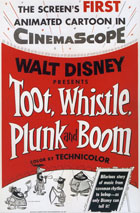 And so we continue our research into what cartoons were submitted to the Academy for Oscar consideration but failed to make the cut. This week:
And so we continue our research into what cartoons were submitted to the Academy for Oscar consideration but failed to make the cut. This week:
1953
The actual nominees were…
CHRISTOPHER CRUMPET (UPA) Robert Cannon
FROM A TO Z-Z-Z-Z (Warner Bros.) Chuck Jones
RUGGED BEAR (Disney) Jack Hannah (Donald Duck)
THE TELL-TALE HEART (UPA) Ted Parmalee
And the Oscar went to…
TOOT, WHISTLE, PLUNK AND BOOM (Disney) Ward Kimball and Charles Nichols, directors.
However – submitted, screened, but NOT nominated were:
 MAGOO GOES SKIING (UPA) Pete Burness
MAGOO GOES SKIING (UPA) Pete Burness
THE FIGUREHEAD (Louis de Rochemont Associates) Halas & Batchelor
JUST DUCKY (MGM) William Hanna & Joseph Barbera
STARTING FROM HATCH (Paramount/Famous Studios) Seymour Kneitel
NO PLACE LIKE ROME (Paramount/Famous Studios) I. Sparber
BOO MOON (Paramount/Famous Studios) Seymour Kneitel
HERMAN, THE CATOONIST (Paramount/Famous Studios) I. Sparber
TOREADORABLE (Paramount/Famous Studios) Seymour Kneitel
HYPNOTIC HICK (Universal/Walter Lantz) Don Patterson
THE FLYING TURTLE (Universal/Walter Lantz) Paul Smith
It’s now 1953 and the threat of television is being felt in Hollywood. 3-D, CinemaScope and other new screen ratios are among the gimmicks introduced to audiences to keep them coming back to the movies, week after week. Even the cartoons were affected by this, as among the films shown at the preliminary ‘cartoon subjects’ screening on January 11th, 1953 included the 3D Hypnotic Hick and Boo Moon (was UPA’s The Tell Tale Heart screening that night in 3D?) and the aforementioned wide screen Toot, Whistle, Plunk and Boom.
Here’s the documentation:
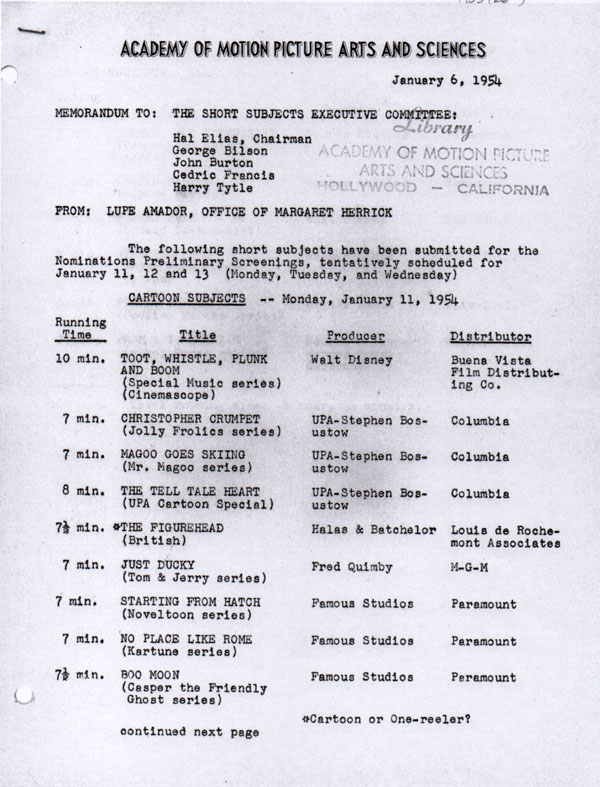
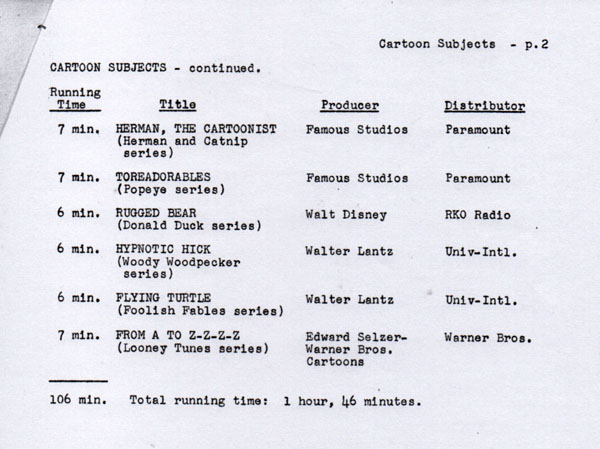
With these posts we ask that you put yourself in their place – which films would you have nominated? Which cartoon should have won? For your edification and viewing pleasure, here are the cartoons that didn’t make the cut (unfortunately not all of them are online – we will update this post when complete intact copies appear). Enjoy the show!
MAGOO GOES SKIING (UPA) Pete Burness
In the Swiss Alps, Mr. Magoo mistakes a St. Bernard for his nephew. That’s essentially the plot. The publicity claimed this was “The funniest cartoon of the year!” No – not quite. But a good solid prime theatrical Magoo for sure. Most forget how popular Mr. Magoo was during the 1950s – these cartoons were well made – and would win several Oscars over the next few years. But not this year. (This cartoon is online only in a Spanish dub – I highly recommend you seek out Shout Factory’s set of all 53 UPA theatrical Magoo’s, gloriously restored on DVD. Buy it here.)

THE FIGUREHEAD (Louis de Rochemont Associates) Halas & Batchelor
Another in Halas and Batchelor’s The Poet and The Painter series, this film is “a fantasy about Neptune’s daughter falling in love with a wooden figurehead of an old ship, and taking this handsome but unresponsive love down to her sea bed.” For John Halas this was an experimental film, “drawing and painting with light”, a technique based on the use of puppets (sometimes stop-motion animated), transparent cels, poloroid screens and filters. Even the Academy itself was confused, and noted on the paperwork above, questioning whether this was a “cartoon” or a live action “one-reeler”.
JUST DUCKY (MGM) William Hanna & Joseph Barbera
Just Ducky is just that – a fine little cartoon, with handsome production values, Tex Avery-style hurt gags and even some heart: Tom and Jerry end the film as friends and the little Quacker is reunited with his family. It’s just not anything new. This isn’t even the first film with the duck (it’s the third). The most recent T&J Oscar wins had a twist: Johann Mouse and Two Musketeers at least had different surroundings. This film was predictable and possibly a bit old hat. My favorite gag here – Jerry throwing a brick (the first animated mouse to do so since Ignatz?) at Tom, shattering his body, leaving only his ink outline!
STARTING FROM HATCH (Paramount/Famous Studios) Seymour Kneitel
This film is sort-of a remake (or as they say today: a “re-boot”) of the first Baby Huey cartoon from 1949, so just in case you missed it, Mr. Academy-member – now that we’ve established the character is popular, here it is again, for the first time! It’s not exactly the same film, but it depicts Huey’s birth (hatching while his Mom is away at the supermarket). By ’53 the Huey formula is well established, and this time the Fox tricks the duck into thinking he’s his Mother. Let the violence and mayhem begin! We get the fox blasting off from a boiling pot to smash his head against a “low ceiling”; his head getting stuck in a bathtub filling with water; and my favorite, getting his tongue flat-ironed into necktie-shape. Throw in a chorus of “It’s a Hap-Hap-Happy Day” and you’ve checked all the boxes of a generic 1950s Famous Studios cartoon. I love it!
NO PLACE LIKE ROME (Paramount/Famous Studios) I. Sparber
I never understood why Famous (or Paramount) submitted Screen Songs (or “Kartune” shorts) to the Academy. Did they really expect Chuck Jones and Walter Lantz to burst out in song? The centerpiece tune is Oh Ma Ma (the Butcher Boy), a song made famous by Rudy Vallee back in the 1930s. The gags surrounding it cover every Italian stereotype you can think of – from eating spaghetti to barbers cutting hair, and singing Opera; from the canals of Venice to the leaning Tower of Pisa – leaving no cliche untouched. The film is so square that the stand out gag is a joke directed towards way-out “modern art”. I’m sure that had the guys from UPA rolling in the aisles!
BOO MOON (Paramount/Famous Studios) Seymour Kneitel
Boo Moon is a Casper cartoon in 3D – and to be honest, its a better film in 3-D. The depth effects really work and what the cartoon may lack in story or character, it more than makes up for it with visual atmosphere and basic charm. The story is a sci-fi remake of Gulliver’s Travels, with Casper as ‘Gulliver’; even the Moon leader, King Luna, is based on the old model sheets of Gulliver’s King Bombo of Blefescu! If you want to see a perfect, restored copy of Boo Moon I urge you to pick up Bob Furmanek’s 3D Rareties blu-ray.
HERMAN, THE CATOONIST (Paramount/Famous Studios) I. Sparber
I selected this cartoon as one of my “top-Ten” Famous Studios cartoons – that doesn’t mean its worthy of an Oscar, but here is what I wrote about it back in this post in 2015:
Clearly the studio observed that the ‘hurt gags’ in MGM’s Tom & Jerry cartoons got the big laughs – and Famous was game to out-do them. The problem is that they removed the context those gags appeared in MGM cartoons – and ignored the funny drawings that made the ‘hurt’ more funny and less painful. The slicing, dicing, punching and pounding Katnip endures can be felt – and audiences often react to Herman & Katnip with shock, not laughter.
Herman The Catoonist takes a meta-approch to the series – here the characters are pen and ink comic strip characters who “come to life” at night, and what ensues is a wall-to-wall blood fest – Katnip biting his own tongue, Herman amputating (erasing) Katnip’s foot and then beheading him with a pair of scissors – and of course, the cat’s demise, balled up in rubber cement, and drowning in Max Fleischer’s inkwell (where we can assume Koko and Fitz will further abuse him). Ahhh… good clean fun.
TOREADORABLE (Paramount/Famous Studios) Seymour Kneitel
“Adorable” is not a word I’d use to describe Toreadorable, a violent Popeye ‘bull-fighting cartoon’ from Tom Johnson’s unit at Famous. It has a fair share of good gags: Bluto using Olive as his “red cape” to attract the bull; Bluto putting Mexican jumping beans into Popeye’s spinach; and puns including the “Inter-Burro” subway and the “Chile Bowl”. The film earns extra points for resisting the urge to punch the Bull into a delicious array of Kosher deli meats.
HYPNOTIC HICK (Universal/Walter Lantz) Don Patterson
The first 30-seconds of Hypnotic Hick is really good – in 3D. After that its essentially a standard Woody Woodpecker versus Buzz Buzzard competition – with Woody hired to serve Buzz with a court summons. Woody tries hypnotism and this leads the chase to atop a skyscraper under construction. They try to milk the depth angle as they run around the steel girders, with Woody riding a paper airplane towards the camera at one point, and tossing money at the audience at another. Love it in 3D – but not even the sight of Buzz Buzzard burping hot rivets could save this one in standard 2D.
THE FLYING TURTLE (Universal/Walter Lantz) Paul Smith
The Flying Turtle isn’t bad – for a 1934 Silly Symphony or a 1948 Terrytoon. But for 1953 its a bit out-dated. True (Spoiler Alert), Lantz kills the character off in the last scene – and not that he doesn’t deserve it. Dal McKennon provides the annoying voice of Herman the turtle (McKennon is one of the great – and underrated – cartoon voice actors of the era). Love the use of color ink lines here – production-wise its fine. It’s just not ambitious enough for an industry in transition, and easy to see why the Academy passed on this one.


 Jerry Beck is a writer, animation producer, college professor and author of more than 15 books on animation history. He is a former studio exec with Nickelodeon Movies and Disney, and has written for The Hollywood Reporter and Variety. He has curated cartoons for DVD and Blu-ray compilations and has lent his expertise to dozens of bonus documentaries and audio commentaries on such. Beck is currently on the faculty of CalArts in Valencia, UCLA in Westwood and Woodbury University in Burbank – teaching animation history. More about Jerry Beck [
Jerry Beck is a writer, animation producer, college professor and author of more than 15 books on animation history. He is a former studio exec with Nickelodeon Movies and Disney, and has written for The Hollywood Reporter and Variety. He has curated cartoons for DVD and Blu-ray compilations and has lent his expertise to dozens of bonus documentaries and audio commentaries on such. Beck is currently on the faculty of CalArts in Valencia, UCLA in Westwood and Woodbury University in Burbank – teaching animation history. More about Jerry Beck [



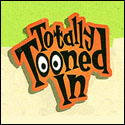



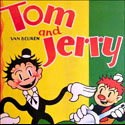
Little trivia to add. This was one of those select years when there was an additional Two-Reel Short Subject category that applied to both live-action and animation. Disney’s BEN & ME got a nomination here. I could potentially see John Sutherland’s A FOR ATOM also getting considered unless it was included for 1952 before its February ’53 release to theaters.
Why was this year so glutted with Famous-Paramount cartoons of such lackluster quality? Maybe it would be easier to put things into perspective if we saw all of the candidates considered for the One-Reel Live-action Short Subject, Documentary Short Subject… and Two-Reel categories. Was it because WEE WATER WONDERS, the latest Grantland Rice Sportlight, the only worthy competition from the mountain-of-stars that year? I can understand why the Terrytoons were overlooked, since 20th Century Fox was busy promoting their live-action CinemaScope orchestra and travelogue specials at this time and Darryl Zanuck probably felt he was well represented already. Also there was the last of their short live “Immortals of Canvas” series, THE JOY OF LIVING: THE ART OF RENOIR.
I suggested earlier that Warner Bros. cartoon head Eddie Selzer may not have been a fan of Chuck Jones and the feelings were mutual, but his unit was the only one with both a consideration and an actually accepted nominee: FROM A TO ZZZZ. Cedric Francis had succeeded deceased Gordon Hollingshead as top shorts producer at Warner Brothers and is listed as a prominent member on the voting committee. There were likely too many live-action shorts being submitted during this period from Warner Brothers, even though the classic John Jay ski film shot in Austria, WINTER PARADISE is the only nominee listed. To be honest, Warner did have the best live-action shorts in the business, especially their Joe McDoakes comedies, Robert Youngson compilations, Sports Parades and Andre de la Varre travelogues. Not that there weren’t notable Columbia Three Stooges Comedies, MGM Pete Smith Specialties, Universal-International Name Band Musicals, RKO-Pathe Sportscopes and other series at this time too, but you could tell which studio took the greatest pride in their product and won more Oscars than anybody else. Sadly it also meant that the Looney Tunes and Merry Melodies had to be overlooked more often than not in order to “balance out the studios” Academy-wise.
I like “Just Ducky” too. It’s so interesting seeing which cartoons were submitted but not nominated.
The reason why Paramount submitted Screen Songs was because the Bouncing Ball series was Paramount’s oldest running animated franchise. These cartoons are important to Ray Pointer since Max Fleischer invented the technique although a different way to animate the bouncing ball compared to Fleischer for Famous/Paramount was used.
And the Oscar winning cartoon and its 3D sequel? Footage lifted from those two cartoons were part of a sing-along video series, even having a Mickey bouncing ball at times (and it was done in a Famousesque way).
The 3D was (Disney’s) “Melody”, the sequel was “Toot Whistle Plunk and Boom:,the Oscar winner of the two as known. Just to put those two in proper order. Little Quacker was pretty good sometimes as other cartoons with that ducling but hbe could bre pretty whinby..LOL In case anybody gets the voice wrong for the duckling, it’s a guy named Red Coffey sic) and Hanna and barbera used him themselves in their HB cartoons, before being replaced by series star Yakky Doodle with ventriloquist Jimmy Weldon providing a happier voice., Quack.
Famous seems to have had the “throw everything at the wall and see if something sticks” attitude towards their submissions to the Academy at this time — outside of Little Audrey or Buzzy, they took one cartoon from every one of their series and shipped them to Hollywood, instead of picking just 1-2 to put up for the Oscar (and IIRC, the cartoons submitted here were done about the time Sparber was writing Art Davis at Warners wondering if he knew where Sid Marcus was, so he could off him a job in Famous’ story department. At least the studio did get smart about this time and put Irv Spector into that department, and Famous’ stories were better in the latter part of the 1950s, even as the animation took a dive due to budget cuts).
HYPNOTIC HICK, one of the funniest Woody Woodpecker cartoons and has remained among my favorites after these many years.
https://www.youtube.com/watch?v=OJnEkIePekc
And the only Woody Woodpecker cartoon that was filmed in 3-D.
I’ve notice that Paul Terry of Terrytoons didn’t submit any of his animated shorts for the 1953 Academy Awards for Best Animated Short Subject including Hot Rods starring Mighty Mouse who tries to stop a group of juvenile delinquents mice terrorizing Mouseville in thier souped out Hot Rods and stopping a gang of cats who kidnap the Hot Rodding mice by duping them with a state of the art Hot Rod.
And UPA’s Frosty the Snowman and The Unicorn in the Garden didn’t get the nod to be selected for Best Animated Short of 1953.
Oh… I just re-read… Leonard Maltin did mention in OF MICE AND MAGIC that Steve Bosustow did not like Bill Hurtz’ UNICORN IN THE GARDEN and refused to enter it. Michael Barrier’s HOLLYWOOD CARTOONS suggests something else may have been going on between Bosustow and Hurtz personally.
UPA’s FROSTY was a limited released 16mm short for TV.
I am tickled to learn that one of my favorite Lantz cartunes of my childhood, THE FLYING TURTLE, was submitted for Oscar consideration. Mr. Beck has it pegged correctly — it’s no misappreciated masterpiece, and certainly didn’t rate an Academy nomination — but the short has something going for it. Young Herman Turtle (with a great, grating Dal McKennon voice) isn’t really likable, but he’s truly determined to learn to fly. The (logical) ending is a little dark (hey, how many cute little characters actually die in a cartoon?), and disturbing (well, it bothered my mother), but Herman does eventually realize his dream, albeit the hard way. I can’t be the only one to remember this odd short with some fondness.
It’s true that BOO MOON looks like just another weakly plotted Casper programmer in TV syndication prints, but after seeing it in the fabulous Bob Furmanek 3D restoration it’s clear that there’s a lot to admire here in terms of style and design. The “resurrection” of the King Bombo character is a highlight.
Did Fred Quimby feel no love for Avery’s ’53 THE THREE LITTLE PUPS? It seems a logical submission. Were there other WB cartoons that deserved consideration? [Wasn’t DUCK DODGERS a ’53 short? I guess Eddie Selzer wouldn’t have submitted BULLY FOR BUGS.]
A while ago, Kurtis Findlay shared Chuck Jones’s own copy of this ballot. He selected: “Christopher Crumpet”, “From A to Z-Z-Z-Z” (duh), “Rugged Bear”, “Toot, Whistle Plunk and Boom” and “Just Ducky”. Kind of fascinating in itself to see how one of the best directors viewed the competition anonymously.
Perhaps in some way, THE FIGUREHEAD was ahead of its time in terms of employing differnet techniques to create an animated film of that nature. One that the Academy wasn’t sure how to classify yet, but one the’ll end up tackling in the ensuing decades. Thank you so much Mr. Halas for having gotten the ball rolling!
The same thing apparently happened with Norman McLaren’s “Neighbours”, which won the Oscar, but for Documentary Short Subject. Apparently the Academy couldn’t decide whether it was live-action or animation, so they put it on the documentary category, which also tells you how loosely they classified documentaries back then.
That is something to think about Tony. Films that undefined convention are the ones that tend to leave a lasting impact in the end I feel. Neighbours certainly deserved its Oscar despite being misplaced in a different category, but it’s look certainly was relatively different form what was considered animation (let alone a “cartoon”) for its time.
I have to admit that I, too, remember “THE FLYING TURTLE” and liked it as an odd cartoon, but I could just imagine the Academy watching this thing and wincing at the ending; wish it ended up on either of the WOODY WOODPECKER AND FRIENDS collections, but I would have voted for “FROM A TO ZZZZZZ”, hands down, or it would have been a toss-up between “THREE LITTLE PUPS” and the afore-mentioned Jones title, if “PUPS” had been nominated. I’ll have to take a look at the list of Warner Brothers cartoons created that year.
I’m surprised that Chuck Jones’ BULLY FOR BUGS or PUNCH TRUNK WB cartoons weren’t nominated.
This is a very good series, Jerry. Thanks to you, I’ve finally seen “The Figurehead”. Over the years I’ve seen many stills from it in animation books (mostly Focal Press), and imagined nice stop motion replacement animation on the characters. In reality, there just ISN’T any replacement stuff in this picture at all. It’s just moving one figure around under the camera lens in tasteful ways. The story is OK, but John Halas tended to publicize his animated films as if they were all masterpieces, while most of them were pretty dull. Without the great Harold Whitaker’s animation, Halas and Bachelor cartoons just sit there. John really exploited the animation book market, such as “Design In Motion” or “The Animated Film” and made sure his pictures got major page space. That Famous Screen Song, surely they jested! It was the usual throwaway gags, animated competently. That gag with the barber and the mirror must have been used in 80 cartoons over the years, “Now show us the back!” They did about the best bouncing ball animation of the series, using squash and stretch cycles for the 16 bar “rests”.
I suppose in some way, Mr. Halas wanted to challenge perceptions of what animation could be, despite resorting to a near live-action approach to how to work around limitations of using models and settings, of which much of the action feels like it takes place just off-camera in many shots. It didn’t help it was quite a short poem that was used for this effort and padding had to be done to stretch it out.
Seeing “The Flying Turtle” reawakened a long-forgotten memory. Back in the ’60’s The Lantz studio revisited “The Flying Turtle” in comic book form, but with an updated and non-fatal ending. As it appeared in a Woody Woodpecker and his friends comic book, the story is nearly identical to the animated cartoon until he discovers the sunken treasure. At that point the story enters the space age. He uses the treasure to buy a rocket! He launches himself in the rocket, sending him into orbit, where it can be assumed cartoon physics allowed him to breathe and live indefinitely. I remember the turtle saying to the reader that technically he wasn’t flying, but falling, but those guys down on the ground don’t need to know that. A happy ending.
A Lantz comics adaptation of THE FLYING TURTLE? Yow! I’d like to see that.
The 50 Greatest Cartoons list that Jerry and others curated, reads and was probably intended as a belated apology to Warner Bros., Tex Avery and the Fleischers for all of Oscar snubs. It’s very telling that only 4 UPA shorts and one Tom and Jerry made that list.
I was age 15 and making my own films in 8mm & 16mm. Writing to the Academy on my newly printed Hale Studios stationary I requested tickets for the upcoming Oscar presentations for the films of 1953. We actually were able to get tickets! The Academy was a bit surprised when we came into pick up our golden Oscar tickets. Having seen all of the Oscar nominated cartoons I was pulling for THE TELL TALE HEART but was still delighted when Disney’s TOOT, WHISTLE, PLUNK & BOOM won as that would have been my second choice. This was the year that Walt Disney took home four Oscars!
I bought that excellent Magoo theatrical box set because I had only seen a couple of those shorts at the drive-in years ago. For a kid weaned on the inferior Magoo TV shorts, The Theatrical Collection 1949-1959 was truly a revelation. Jerry Beck’s input in the extras was the icing on the cake.